Abstract
There is an overwhelming body of evidence that certain Staphylococcus aureus strains become more sensitive to killing by polymorphonuclear leukocytes after their growth in media containing subinhibitory concentrations of penicillin. However, it is not clear to what extent this phenomenon contributes to the curative effect of penicillin in vivo. To explore its therapeutic relevance, we evaluated the interaction of staphylococci pretreated with penicillin in vitro with leukocytes in cell-proof diffusion chambers (porosity, 0.22 micron) implanted subcutaneously in rabbits. Under this in vivo environment, staphylococci pretreated with penicillin remained hypersensitive to leukocyte killing as under in vitro conditions. Furthermore, when the staphylococci were mixed with the leukocytes in chambers implanted intraperitoneally in mice which subsequently received intravenously a suboptimal dose of penicillin, they also became hypersensitive to leukocytic killing. However, because the staphylococcal growth rate was considerably reduced in vivo, the degree of penicillin-induced sensitivity to leukocytic killing was smaller than that obtained in test tube cultures; nevertheless, the enhanced killing was significant. Additional support that the curative effect of penicillin partly depends on its synergistic action with the leukocytes was provided by the relative decrease in virulence of staphylococci pretreated with penicillin in mice in which the cellular host defenses were already recruited at the focus of inoculation. These observations indicate that penicillin-induced hypersensitivity of staphylococci to leukocytic killing is not only an in vitro phenomenon, but an effect which has therapeutic relevance.
Full text
PDF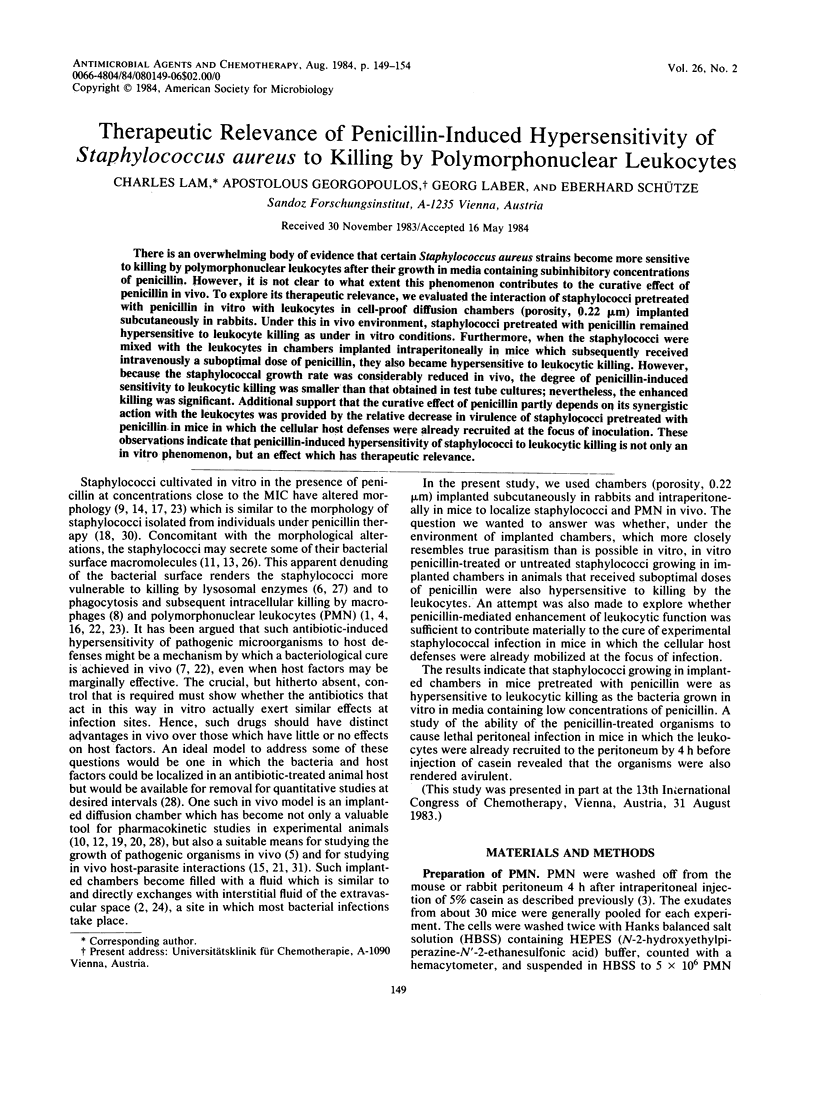
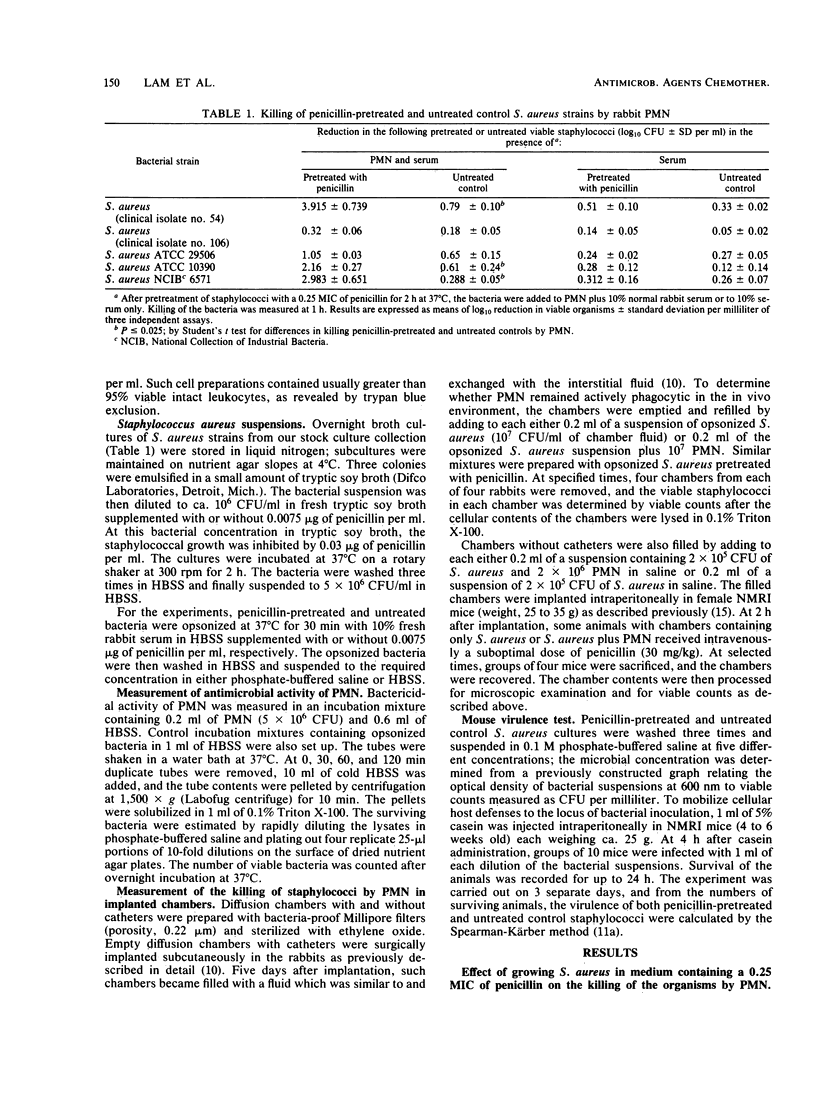
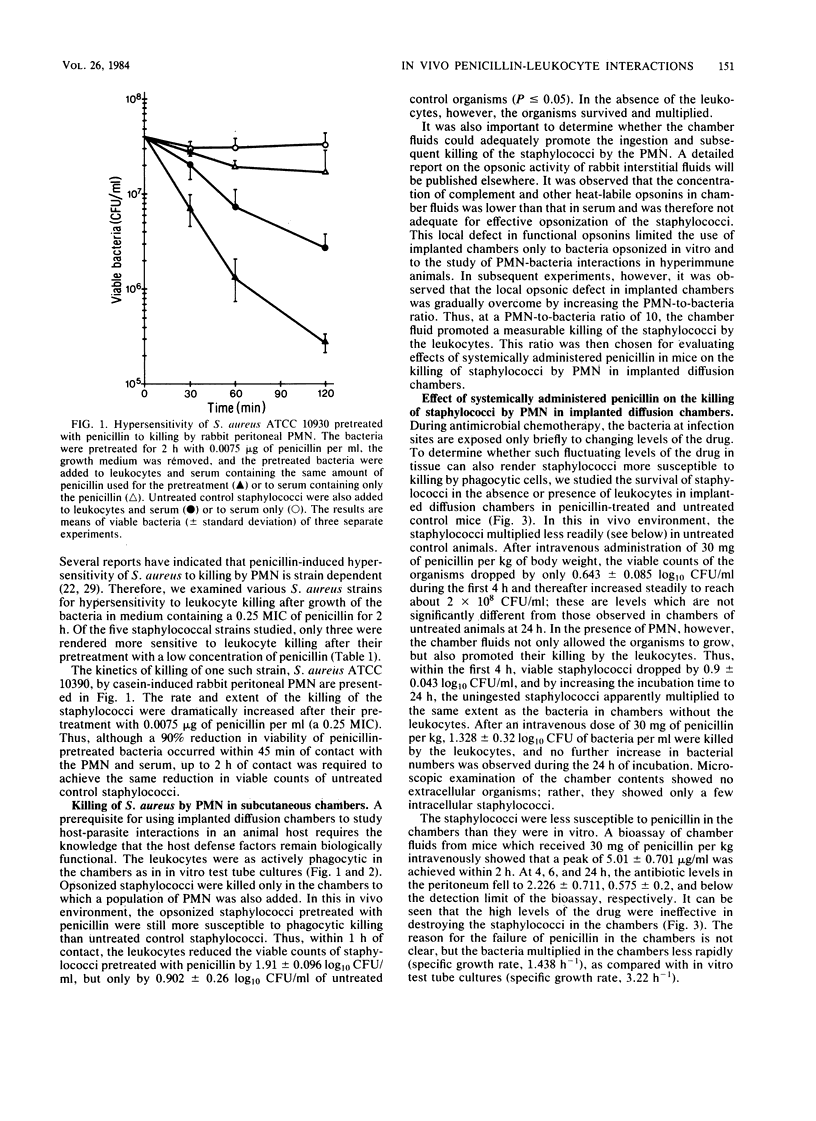
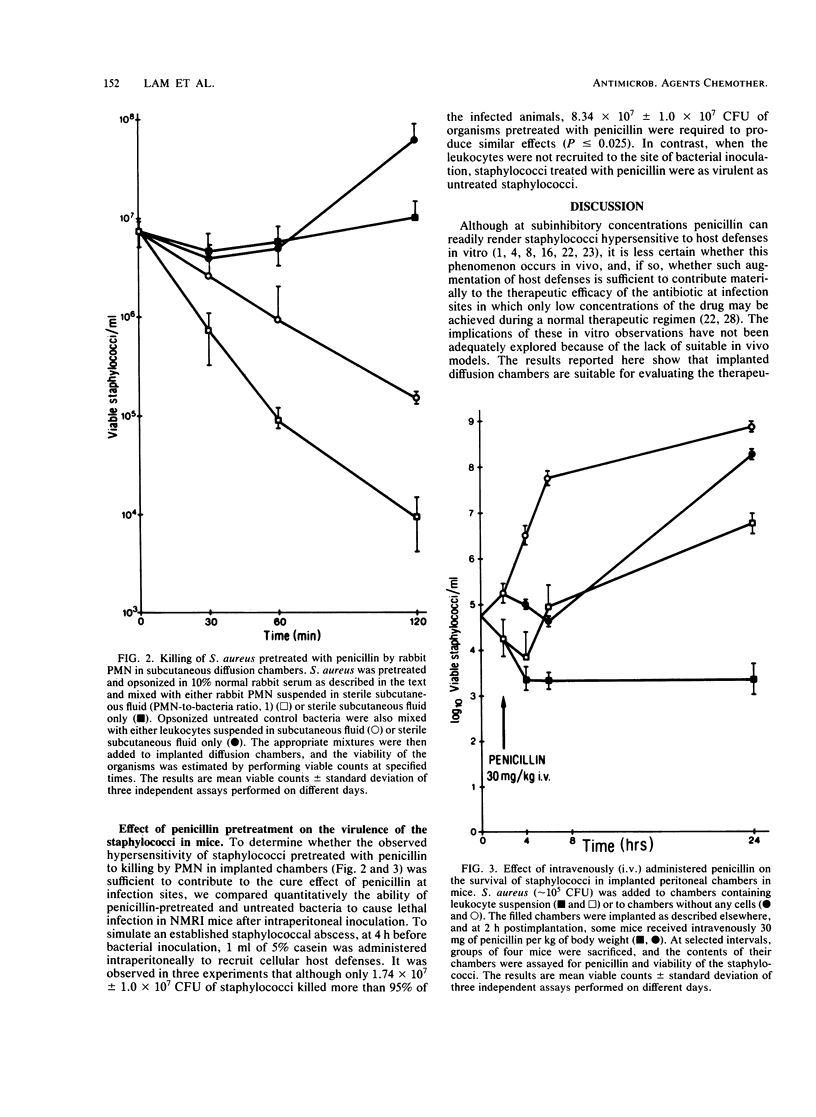
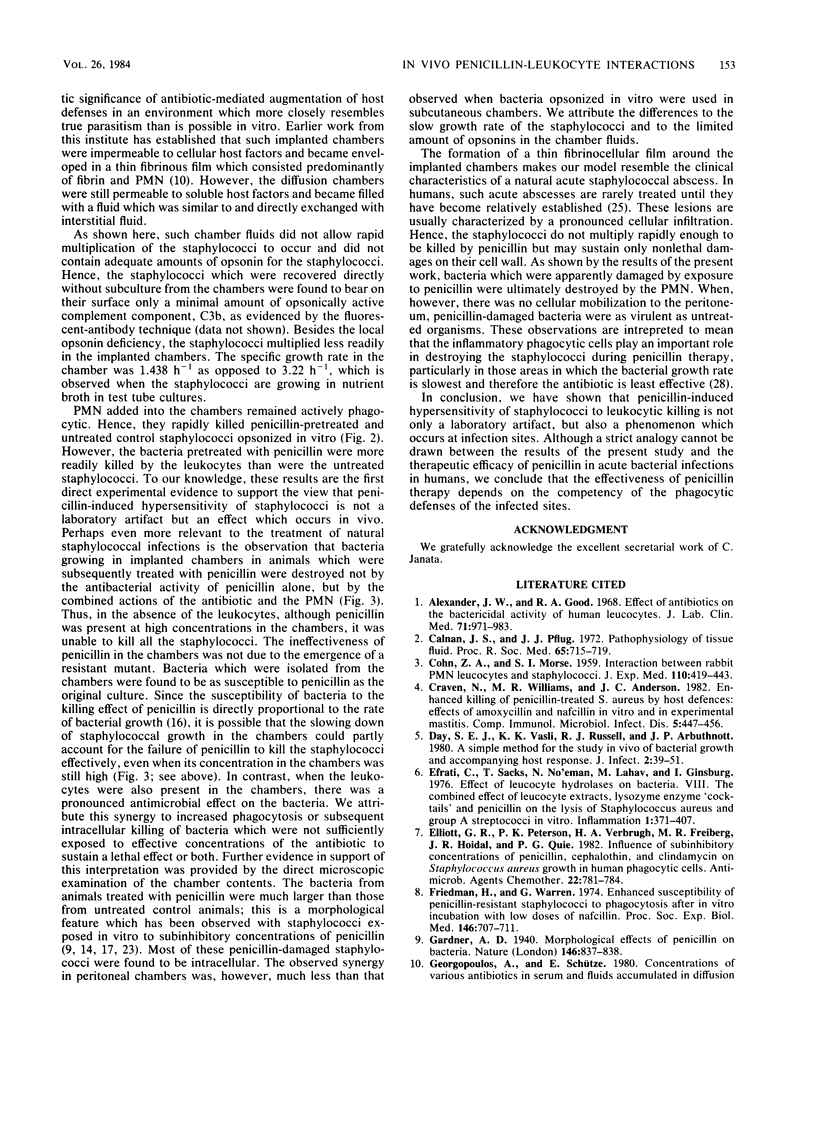
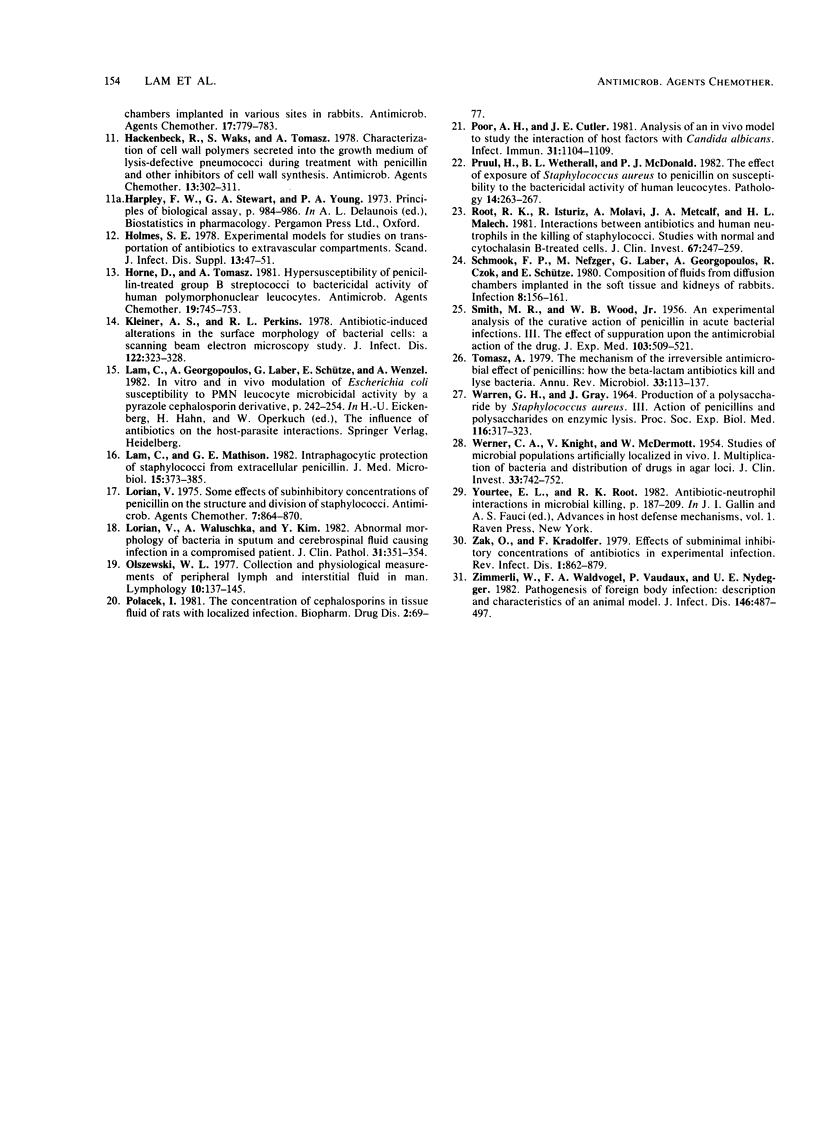
Selected References
These references are in PubMed. This may not be the complete list of references from this article.
- Alexander J. W., Good R. A. Effect of antibiotics on the bactericidal activity of human leukocytes. J Lab Clin Med. 1968 Jun;71(6):971–983. [PubMed] [Google Scholar]
- COHN Z. A., MORSE S. I. Interactions between rabbit polymorphonuclear leucocytes and staphylococci. J Exp Med. 1959 Sep 1;110:419–443. doi: 10.1084/jem.110.3.419. [DOI] [PMC free article] [PubMed] [Google Scholar]
- Calnan J. S., Pflug J. J., Chisholm G. D., Taylor L. M. Pathophysiology of tissue fluid. Proc R Soc Med. 1972 Aug;65(8):715–719. [PMC free article] [PubMed] [Google Scholar]
- Craven N., Williams M. R., Anderson J. C. Enhanced killing of penicillin-treated S. aureus by host defences: effects of amoxycillin, cloxacillin and nafcillin in vitro and in experimental mastitis. Comp Immunol Microbiol Infect Dis. 1982;5(4):447–456. doi: 10.1016/0147-9571(82)90071-6. [DOI] [PubMed] [Google Scholar]
- Day S. E., Vasli K. K., Russell R. J., Arbuthnott J. P. A simple method for the study in vivo of bacterial growth and accompanying host response. J Infect. 1980 Mar;2(1):39–51. doi: 10.1016/s0163-4453(80)91773-9. [DOI] [PubMed] [Google Scholar]
- Elliott G. R., Peterson P. K., Verbrugh H. A., Freiberg M. R., Hoidal J. R., Quie P. G. Influence of subinhibitory concentrations of penicillin, cephalothin, and clindamycin on Staphylococcus aureus growth in human phagocytic cells. Antimicrob Agents Chemother. 1982 Nov;22(5):781–784. doi: 10.1128/aac.22.5.781. [DOI] [PMC free article] [PubMed] [Google Scholar]
- Friedman H., Warren G. H. Enhanced susceptibility of penicillin-resistant staphylococci to phagocytosis after in vitro incubation with low doses of nafcillin. Proc Soc Exp Biol Med. 1974 Jul;146(3):707–711. doi: 10.3181/00379727-146-38177. [DOI] [PubMed] [Google Scholar]
- Hakenbeck R., Waks S., Tomasz A. Characterization of cell wall polymers secreted into the growth medium of lysis-defective pneumococci during treatment with penicillin and other inhibitors of cell wall synthesis. Antimicrob Agents Chemother. 1978 Feb;13(2):302–311. doi: 10.1128/aac.13.2.302. [DOI] [PMC free article] [PubMed] [Google Scholar]
- Holm S. E. Experimental models for studies on transportation of antibiotics to extravasal compartments. Scand J Infect Dis Suppl. 1978;(13):47–51. [PubMed] [Google Scholar]
- Horne D., Tomasz A. Hypersusceptibility of penicillin-treated group B streptococci to bactericidal activity of human polymorphonuclear leukocytes. Antimicrob Agents Chemother. 1981 May;19(5):745–753. doi: 10.1128/aac.19.5.745. [DOI] [PMC free article] [PubMed] [Google Scholar]
- Klainer A. S., Perkins R. L. Antibiotic-induced alterations in the surface morphology of bacterial cells: a scanning-beam electron miscroscopy study. J Infect Dis. 1970 Oct;122(4):323–328. doi: 10.1093/infdis/122.4.323. [DOI] [PubMed] [Google Scholar]
- Lam C., Mathison G. E. Intraphagocytic protection of staphylococci from extracellular penicillin. J Med Microbiol. 1982 Aug;15(3):373–385. doi: 10.1099/00222615-15-3-373. [DOI] [PubMed] [Google Scholar]
- Lorian V. Some effect of subinbilitory concentrations of penicillin on the structure and division of staphylococci. Antimicrob Agents Chemother. 1975 Jun;7(6):864–867. doi: 10.1128/aac.7.6.864. [DOI] [PMC free article] [PubMed] [Google Scholar]
- Olszewski W. L. Collection and physiological measurements of peripheral lymph and interstitial fluid in man. Lymphology. 1977 Jun;10(2):137–145. [PubMed] [Google Scholar]
- Polacek I. The concentrations of cephalosporins in tissue fluid of rats with localized infection. Biopharm Drug Dispos. 1981 Jan-Mar;2(1):69–77. doi: 10.1002/bdd.2510020108. [DOI] [PubMed] [Google Scholar]
- Poor A. H., Cutler J. E. Analysis of an in vivo model to study the interaction of host factors with Candida albicans. Infect Immun. 1981 Mar;31(3):1104–1109. doi: 10.1128/iai.31.3.1104-1109.1981. [DOI] [PMC free article] [PubMed] [Google Scholar]
- Pruul H., Wetherall B. L., McDonald P. J. The effect of exposure of Staphylococcus aureus to penicillin on susceptibility to the bactericidal activity of human leukocytes. Pathology. 1982 Jul;14(3):263–267. doi: 10.3109/00313028209061375. [DOI] [PubMed] [Google Scholar]
- Root R. K., Isturiz R., Molavi A., Metcalf J. A., Malech H. L. Interactions between antibiotics and human neutrophils in the killing of staphylococci. J Clin Invest. 1981 Jan;67(1):247–259. doi: 10.1172/JCI110020. [DOI] [PMC free article] [PubMed] [Google Scholar]
- SMITH M. R., WOOD W. B., Jr An experimental analysis of the curative action of penicillin in acute bacterial infections. III. The effect of suppuration upon the antibacterial action of the drug. J Exp Med. 1956 Apr 1;103(4):509–522. doi: 10.1084/jem.103.4.509. [DOI] [PMC free article] [PubMed] [Google Scholar]
- Schmook F. P., Nefzger M., Laber G., Georgopoulos A., Czok R., Schütze E. Composition of fluids from diffusion chambers implanted in the soft tissue and kidneys of rabbits. Infection. 1980;8(4):156–161. doi: 10.1007/BF01639123. [DOI] [PubMed] [Google Scholar]
- Tomasz A. The mechanism of the irreversible antimicrobial effects of penicillins: how the beta-lactam antibiotics kill and lyse bacteria. Annu Rev Microbiol. 1979;33:113–137. doi: 10.1146/annurev.mi.33.100179.000553. [DOI] [PubMed] [Google Scholar]
- WARREN G. H., GRAY J. PRODUCTION OF A POLYSACCHARIDE BY STAPHYLOCOCCUS AUREUS. 3. ACTION OF PENICILLINS AND POLYSACCHARIDES ON ENZYMIC LYSIS. Proc Soc Exp Biol Med. 1964 Jun;116:317–323. doi: 10.3181/00379727-116-29236. [DOI] [PubMed] [Google Scholar]
- WERNER C. A., KNIGHT V., McDERMOTT W. Studies of microbial populations artificially localized in vivo. I. Multiplication of bacteria and distribution of drugs in agar loci. J Clin Invest. 1954 May;33(5):742–752. doi: 10.1172/JCI102943. [DOI] [PMC free article] [PubMed] [Google Scholar]
- Zak O., Kradolfer F. Effects of subminimal inhibitory concentrations of antibiotics in experimental infections. Rev Infect Dis. 1979 Sep-Oct;1(5):862–879. doi: 10.1093/clinids/1.5.862. [DOI] [PubMed] [Google Scholar]
- Zimmerli W., Waldvogel F. A., Vaudaux P., Nydegger U. E. Pathogenesis of foreign body infection: description and characteristics of an animal model. J Infect Dis. 1982 Oct;146(4):487–497. doi: 10.1093/infdis/146.4.487. [DOI] [PubMed] [Google Scholar]


